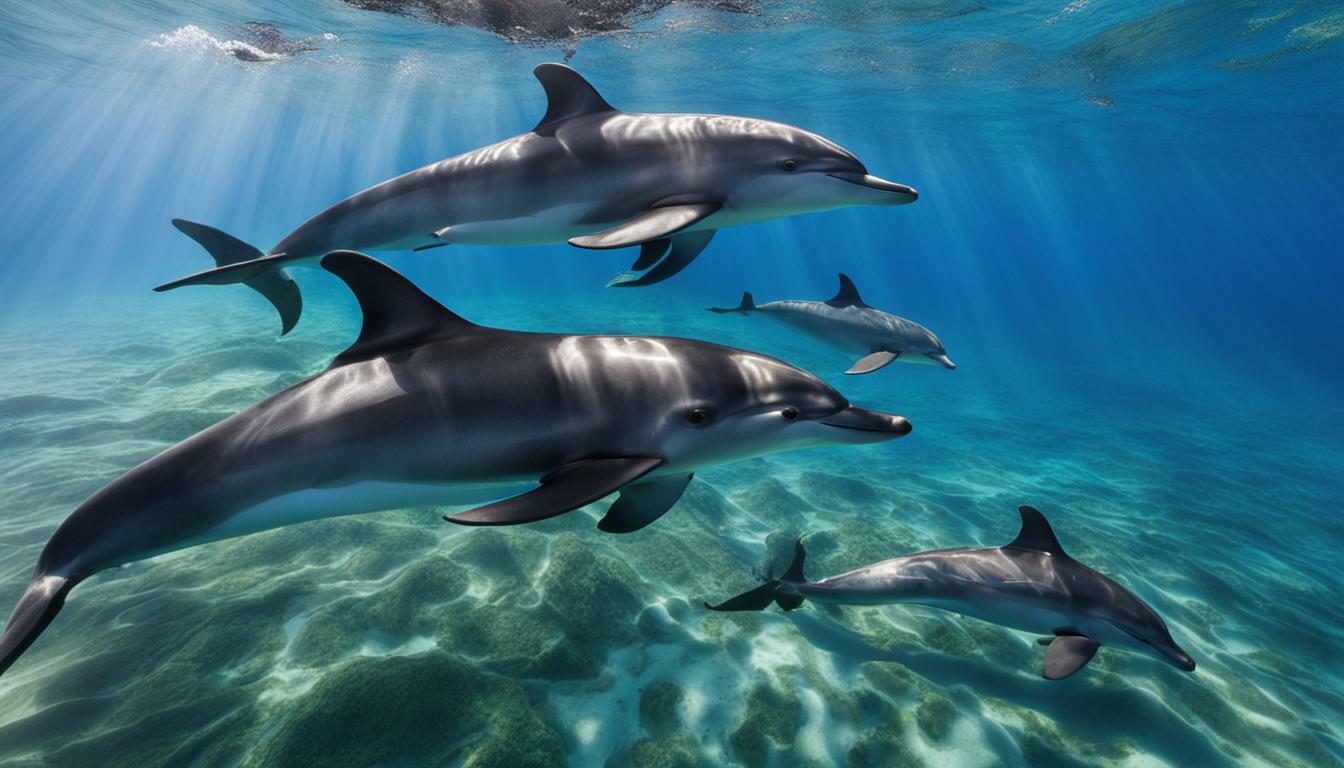Dolphins are known for their remarkable migration patterns, which play a vital role in their species’ survival. In this section, we will delve into the intriguing world of dolphins’ migration patterns. We will explore their journeys, behaviors, and how these patterns impact their survival.
Recent research suggests that water temperature is a crucial factor triggering dolphin migratory movements. Bottlenose dolphins, specifically those in the United States, migrate along the Atlantic coast, heading north in the spring and south in the autumn. When water temperatures drop, dolphins tend to begin their migration, moving south to warmer waters.
Not only does water temperature influence their migration, but the availability of prey and salt content in the water also impact their patterns. Understanding these factors is key to comprehending and predicting dolphin migration routes.
To aid in the study of dolphin migration, researchers track individual dolphins using their unique dorsal fins and characteristic scratches and notches. This identification method allows for better understanding of their movements and behaviors. By monitoring water salinity and temperature, it may be possible to predict dolphin migrations and reduce the risk of fatal encounters with trawlers.
Overall, understanding and studying dolphins’ migration patterns is crucial for their conservation. By gaining insight into their journeys and the factors that influence their movements, we can work towards protecting these incredible marine mammals and ensuring their survival for future generations.
Factors Influencing Dolphin Migration
Several factors contribute to the migration behavior of dolphins, including oceanic conditions and the availability of food sources. Recent research suggests that water temperature plays a crucial role in triggering their migratory movements. When water temperatures drop, dolphins tend to begin migration, moving south to warmer waters. This behavior is believed to be driven by the need to seek out more favorable conditions for their survival.
Prey availability also influences dolphin migration patterns. As opportunistic feeders, dolphins rely on a steady supply of fish and other small marine creatures. They follow the movements of their prey, which can vary with seasonal changes and oceanic currents. By tracking the availability of food sources, researchers can better understand the migration patterns of dolphins and their reliance on specific habitats.
In addition to water temperature and prey availability, the salt content in the water also affects dolphin migration. Dolphins, like other marine animals, have a specific tolerance for salinity levels. Changes in salt content can impact their ability to find suitable feeding grounds and navigate through different marine environments. Monitoring these saltwater conditions is crucial for predicting dolphin migrations and ensuring their conservation.
Understanding the Impact
“By studying the factors that influence dolphin migration, we can gain valuable insights into their behavior and better protect their populations,” said marine biologist Dr. Jane Harper. “This information helps us anticipate their movement patterns and take proactive measures to prevent fatal encounters with trawlers, which can have devastating consequences for these magnificent creatures.”
Through the use of advanced research methods, scientists can track individual dolphins using unique identifiers such as dorsal fins and characteristic markings. This tracking enables researchers to map their migratory routes and gain a deeper understanding of their movements. By combining these findings with data on water salinity, temperature, and prey availability, conservation efforts can be better tailored to protect dolphins throughout their migratory journeys.
| Factor | Influence on Dolphin Migration |
|---|---|
| Water Temperature | Triggers migratory movements, with dolphins moving south to warmer waters when temperatures drop. |
| Prey Availability | Influences migration patterns as dolphins follow the movements of their food sources. |
| Salt Content | Affects dolphins’ ability to find suitable feeding grounds and navigate through different marine environments. |
Dolphin Migration Routes
Dolphins, especially bottlenose dolphins found along the Atlantic coast of the United States, follow specific migration routes as they travel north in the spring and south in the autumn. These routes have been the subject of extensive research, providing valuable insights into the navigation patterns of these marine mammals.
Studies have shown that water temperature plays a significant role in triggering the migratory movements of dolphins. As the water begins to cool in the autumn, dolphins start their journey southward in search of warmer waters. Conversely, in the spring, when water temperatures rise, they migrate northward. This behavior suggests that dolphins have a strong sense of temperature changes and utilize this information to guide their migration.
While temperature is a crucial factor, other environmental conditions also impact dolphin migration patterns. The availability of prey is another important consideration. Dolphins follow the movement of their prey, such as schools of fish, as they migrate along the coast. By tracking their food sources, dolphins are able to ensure a consistent supply of food throughout their migratory journey.
Researchers have also found that the salt content in the water affects dolphin migration. Dolphins have a preference for waters with specific salinity levels and are more likely to follow routes that align with their saltwater preferences. This further emphasizes the sophisticated navigation abilities of these remarkable creatures.
Table: Factors Influencing Dolphin Migration
| Factors | Impact on Dolphin Migration |
|---|---|
| Water Temperature | Triggers migratory movements |
| Prey Availability | Follows food sources |
| Salt Content | Preference for specific salinity levels |
To track dolphin migration, researchers have developed methods that involve identifying individual dolphins based on their unique dorsal fins and characteristic markings. This allows researchers to monitor the movements of specific dolphins over time, gaining valuable insights into their migration routes and behavior.
Understanding dolphin migration patterns is crucial for their conservation. By monitoring factors such as water salinity and temperature, scientists can predict and anticipate their migrations, preventing potentially fatal encounters with trawlers and other human activities. This knowledge is essential in ensuring the protection of these intelligent and majestic marine mammals.
Research Methods and Tracking
Researchers employ various methods, including tracking individual dolphins through their distinct dorsal fins and identifying characteristic scratches and notches, to study dolphin migration patterns. These methods provide valuable insights into their movements and behavior, helping us understand the factors that influence their migratory routes.
One commonly used method is photo-identification, where researchers capture images of dolphins’ dorsal fins and compare them to a catalog of known individuals. Each dolphin’s fin has unique markings, such as scars or notches, which serve as natural “fingerprints.” By comparing these markings over time, scientists can track individual dolphins and determine their migration patterns.
In addition to photo-identification, satellite tracking is also employed to monitor dolphin movements. This technology involves attaching a small transmitter to a dolphin’s dorsal fin, which then sends signals to satellites. These signals provide real-time data on the dolphin’s location, allowing researchers to map their migration routes and understand how they adapt to changes in their environment.
The table below summarizes the research methods and tracking techniques used in studying dolphin migration:
| Research Method | Description |
|---|---|
| Photo-Identification | Comparing unique dorsal fin markings to track individual dolphins over time. |
| Satellite Tracking | Attaching transmitters to dolphins’ dorsal fins to monitor their movements via satellite signals. |
These research methods and tracking techniques have revolutionized our understanding of dolphin migration. By combining field observations, photo-identification, and satellite tracking, scientists can gather comprehensive data on migration patterns, habitat preferences, and responses to environmental changes. This knowledge is crucial for developing effective conservation strategies to protect these remarkable marine animals.
How do dolphins’ physical characteristics and adaptations contribute to their migration patterns?
Dolphins’ physical features and adaptive traits play a vital role in their migration patterns. Their streamlined bodies and sleek fins enable swift swimming, making long-distance travel more efficient. A powerful tail allows them to generate propulsion, while their streamlined shape reduces drag. Additionally, their ability to regulate body temperature and store oxygen efficiently enhances endurance, enabling successful migrations across vast oceanic expanses.
Implications for Conservation
Understanding dolphin migration patterns is crucial for their conservation, as it allows researchers to predict their movements and minimize potential conflicts with human activities.
Bottlenose dolphins, particularly those found along the Atlantic coast of the United States, exhibit seasonal migrations. In the spring, they head northward, while in the autumn, they move southward. Recent studies have revealed that water temperature plays a significant role in triggering these migratory behaviors. When water temperatures drop, dolphins begin their journey towards warmer waters.
The availability of prey and the salt content in the water are also influential factors in their migration patterns. Dolphins are known to follow their food sources, and the abundance or scarcity of prey can impact their movement. The salt content in the water affects their ability to maintain proper hydration levels and influences their choice of migratory routes.
To better understand these migration patterns, researchers employ various tracking methods, such as studying the unique dorsal fins and characteristic markings of individual dolphins. By monitoring water salinity and temperature, scientists can potentially predict dolphin migrations and take preventive measures to reduce fatal encounters with trawlers and other human activities.







